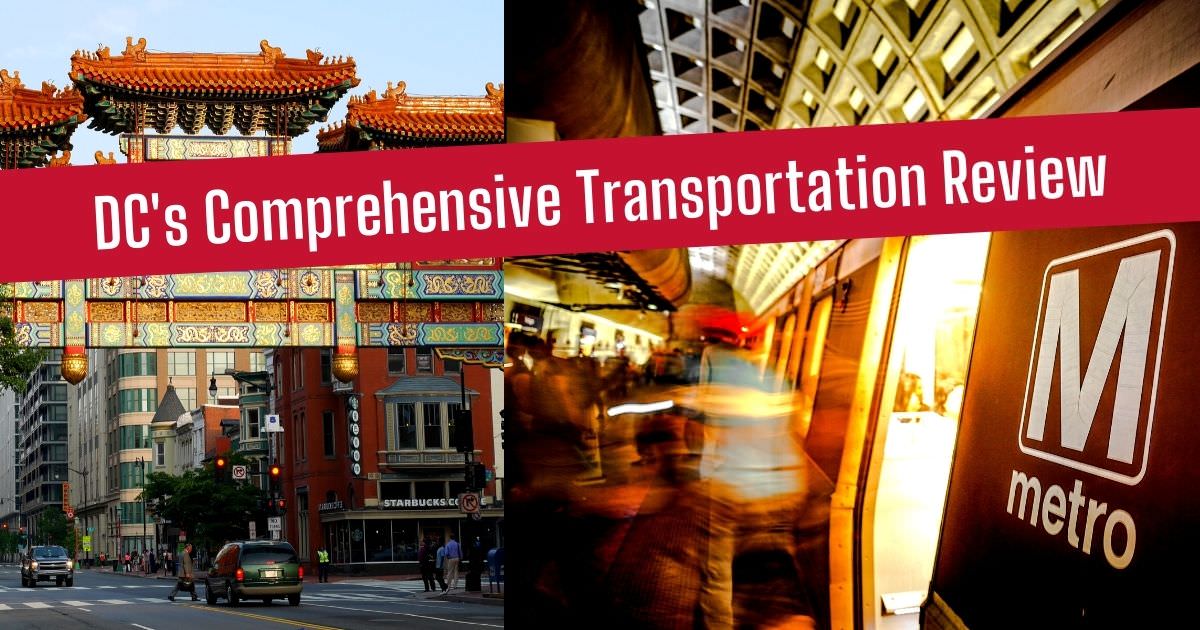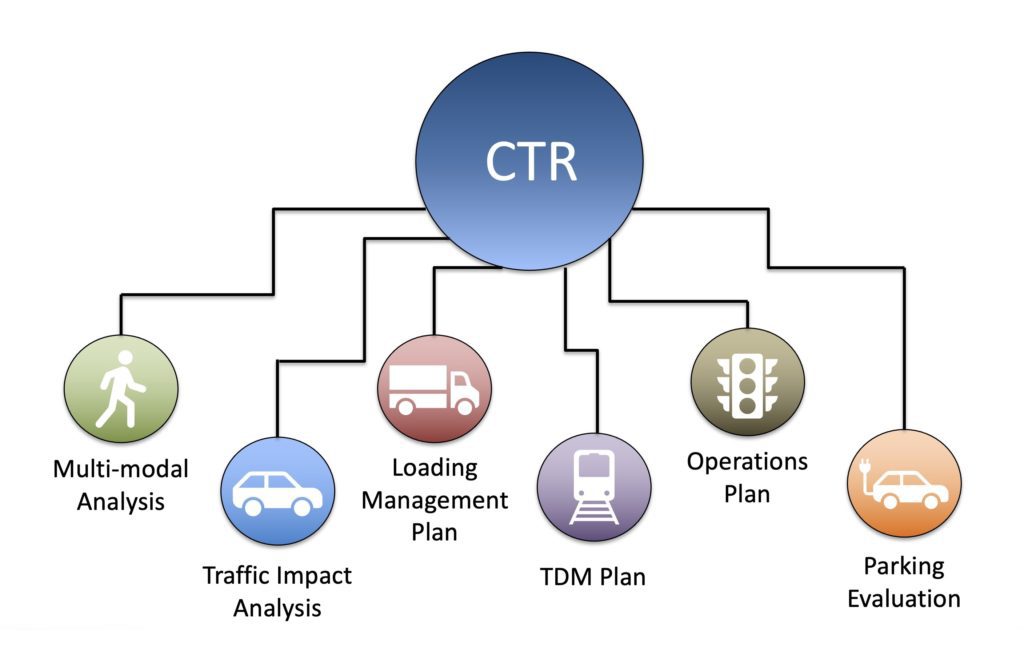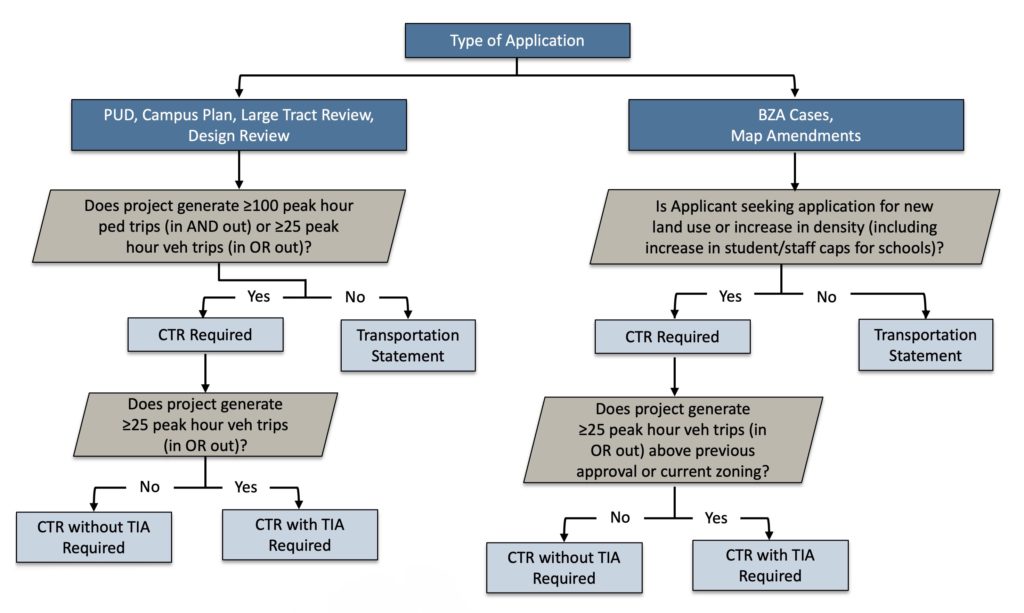The District of Columbia often requires development proposals to have a traffic engineer perform a Comprehensive Transportation Review (CTR) to assess how a proposed development will affect the surrounding transportation network. CTRs differ from traditional traffic impact analyses because they include a multimodal evaluation and are not just focused on vehicular impacts. It is the responsibility of developers to complete a CTR early in the development process. Our DC traffic engineering team explains.
DDOT’s Comprehensive Transportation Review Explained
The District Department of Transportation (DDOT) uses the CTR to evaluate overall impacts and proposed mitigations relating to a proposed development.
What is a Comprehensive Transportation Review? DDOT’s guidelines state that the CTR is:
“the evaluation of current and future transportation operations, the identification of impacts to transportation networks, and a plan to address impacts due [to] the trips generated by a project.” (1)
Importantly, the purpose of a CTR is not to identify improvements to solve existing transportation problems. Rather, a CTR focuses on impacts caused by traffic associated with a specific project and includes a plan to address impacts due the trips generated by the project.
CTRs include one or more of the following components:
- Traffic Impact Analysis
- Multimodal Analysis
- Loading Management Plan
- TDM Plan
- Operations Plan
- Parking Evaluation
Some CTR projects such as for this District of Columbia school, require the development of a comprehensive package of transportation improvements to accommodate the proposed development, including physical roadway improvements, a Transportation Demand Management Plan, an Operations Management Plan, and a Performance Monitoring Plan
CTR Requirements and Trip Thresholds
Depending on the type of application, a CTR is required either when a project generates 100 or more peak hour pedestrian trips or more than 25 peak hour/peak direction vehicle trips, or if the applicant is seeking approval for a new land use or an increase in density. If these requirements are not met, an abbreviated Transportation Statement may be required in lieu of a CTR. You can learn more about Transportation Statements here.
This chart explains the conditions that must be met for a CTR to be required for a new development.
DDOT’s 2019 CTR Guidelines: A New Focus on Parking, Multimodal, and TDM
DDOT released its first CTR guidelines in 2012. Prior to 2012, the CTR focused on the traditional traffic impact study. In the years after 2012, DDOT became a national leader in multimodal studies, de-emphasizing the traffic impact analysis and introducing the concept that availability of parking for the use is the generator for vehicle trips. In June 2019, DDOT implemented new CTR guidelines. The 2019 guidelines have a greater focus on site design, parking, and TDM. They:
- Introduce on-site vehicle parking maximums by use and proximity to transit,
- Incorporate DDOT’s Vision Zero principles, and
- Make traffic impact studies just one component of a broader multimodal evaluation.
The 2019 CTR guidelines also emphasize Transportation Demand Management (TDM) and require developers to provide a TDM plan to discourage driving and encourage transit usage, with the scale of the TDM plan based on parking supply and impacts identified in the CTR.
The guidelines also focus on curbside management in order to accommodate the curbside needs of a site and address rapidly evolving pick-up/drop-off trends.
Other DDOT priorities under CTRs include (2, 3):
- Site Access + Connectivity – alley access should be used if available, curb cuts should be minimized, the property should provide connectivity with neighboring properties while breaking up superblocks,
- Loading Management should provide for head-in/head-out from alley and berths, no backing through public spaces, and the accommodation of loading/trash operations on private property
- Transit Supportive – sites should encourage transit ridership through pedestrian connections and proximity to transit, and
- Bike Facilities should meet or exceed zoning requirements for bike parking and shower/changing facilities, and bike facilities should be in easily accessible locations.
If you would like more information about DDOT’s Comprehensive Transportation Review requirements and how they apply to your project, don’t hesitate to reach out to Jami Milanovich of our Washington DC transportation consulting team.
Notes
- DDOT Guidelines for Comprehensive Transportation Review (CTR) Requirements, August 2012
- Guidance for Comprehensive Transportation Review (CTR) 2019 Edition – June 2019
- Guidance for Comprehensive Transportation Review (CTR) 2019 Edition – Dec 2019
Contact our District of Columbia CTR Team

Jami L. Milanovich, P.E.
Principal | (202) 556-1113
jlmilanovich@wellsandassociates.com
A registered Professional Engineer, Jami has over two decades of experience creating innovative transportation solutions in the District of Columbia. Her work includes traffic impact studies, parking analyses, intersection improvement design, loading management plans, site access studies, and expert witness testimony.
Jim Watson, AICP, PTP
Senior Associate | (301) 971-3417
jwwatson@wellsandassociates.com
Jim Watson is a transportation planner with over 15 years of experience in multimodal planning and design in the private and public sectors, notably in the District of Columbia where he has experience with comprehensive transportation reviews, parking and traffic analyses, transit-oriented development, traffic design, campus planning, and more.




